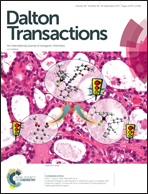A 4-dimethylaminobenzoate-functionalized Ti6-oxo cluster with a narrow band gap and enhanced photoelectrochemical activity: a combined experimental and computational study†
Abstract
Organic donor–π-bridge-acceptor (D–π-A) dyes with arylamines as an electron donor have been widely used as photosensitizers for dye-sensitized solar cells (DSSCs). However, titanium-oxo clusters (TOCs) functionalized with this kind of D–π-A structured dye-molecule have rarely been explored. In the present study, the 4-dimethylaminobenzoate-functionalized titanium-oxo cluster [Ti6(μ3-O)6(OiPr)6(DMABA)6]·2C6H5CH3 (DMABA = 4-dimethylaminobenzoate) was synthesized and structurally characterized by single-crystal X-ray diffraction. For comparison, two other Ti6-oxo clusters, namely [Ti6(μ3-O)6(OiPr)6(AD)6] (AD = 1-adamantanecarboxylate) and [Ti6(μ3-O)2(μ2-O)(μ2-OiPr)4(OiPr)10(DMM)2] (DMM = dimethylmalonate), were also studied. The DMABA-functionalized cluster exhibits a remarkably reduced band gap of ∼2.5 eV and much enhanced photocurrent response in comparison with the other two clusters. The electronic structures and electronic transitions of the clusters were studied by DFT and TDDFT calculations. The computational results suggest that the low-energy transitions of the DMABA-functionalized cluster have a substantial charge-transfer character arising from the DMABA → {Ti6} cluster core ligand-to-core charge transfer (LCCT), along with the DMABA-based intra-ligand charge transfer (ILCT). These low-energy charge transfer transitions provide efficient electron injection pathways for photon-to-electron conversion.



 Please wait while we load your content...
Please wait while we load your content...